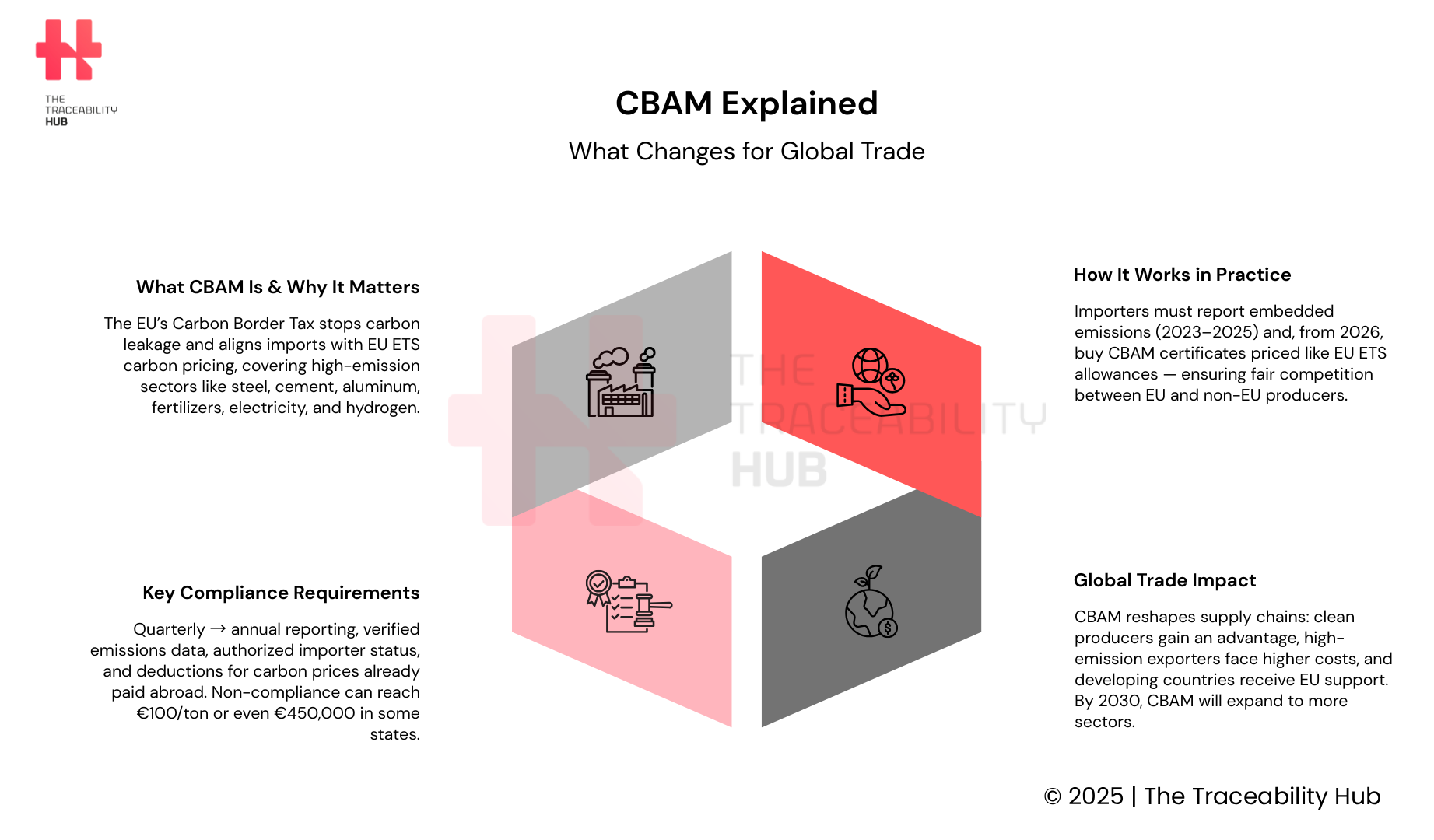CBAM as a Transformative Climate & Trade Instrument
The EU’s CBAM regulation marks a fundamental change in carbon emission management for global trade. The EU Carbon Border Tax started with key sectors like iron and steel, cement, fertilizers, aluminum, electricity, and hydrogen. This regulation will expand to cover more than 50% of emissions in EU Emissions Trading System sectors (EU ETS). These products make up about 3% of what the EU imports.
Carbon emissions would leak overseas at a rate of 0.19 tons for each ton of CO₂ avoided within the EU without CBAM. The regulation wants to stop this carbon leakage and promote cleaner industrial production worldwide. CBAM plays a vital role in the “Fit for 55 in 2030 package” to help the EU reach its target of cutting greenhouse gas emissions by at least 55% by 2030 compared to 1990 levels.
The regulation timeline includes a transitional phase from 2023 to 2025 that focuses on its coverage requirements. Financial obligations will begin in 2026 when the definitive regime takes effect. This complete approach will give a 99% coverage of embedded emissions in imported CBAM goods. The system also aims to reduce regulatory burden and compliance costs for EU companies, particularly SMEs.
CBAM Explained: Purpose and Link to EU ETS
The Carbon Border Adjustment Mechanism (CBAM) tackles a basic challenge in EU climate policy implementation. The EU designed this policy to prevent ambitious domestic emissions reduction from causing pollution to move elsewhere. A carefully designed regulatory framework helps achieve several connected objectives.
Carbon Leakage and the Rationale for a Carbon Border Tax
Businesses often move their carbon-intensive production to countries that have less strict climate policies, creating carbon leakage. This creates a double problem. EU production goes down while global emissions rise instead of falling. Research shows that overseas “leakage” accounts for about 0.19 tons of CO₂ for every ton avoided in the EU through stricter regulations. European industries face unfair competition from foreign producers who don’t pay equivalent carbon prices.
How CBAM Complements the EU Emissions Trading System
The EU Emissions Trading System (ETS) has been the flagship policy of EU climate policy since 2005. It relied on free emissions allowances to protect sectors at high leakage risk. This approach didn’t work well – companies that received 100% free allowances had little reason to cut emissions or invest in cleaner technologies.
The “CBAM factor” will replace these free allowances gradually. It starts at 97.5% in 2026 and drops to 14% by 2033. This will give imported goods carbon costs equal to what EU producers pay under the ETS. CBAM certificates’ prices directly reflect the weekly average auction price of EU ETS allowances, creating fair competition.
WTO Compatibility and Legal Framework of the EU CBAM Regulation
The EU’s CBAM follows World Trade Organization (WTO) rules. Countries like Brazil, China, India, and South Africa worry that CBAM might be hidden protectionism.
The WTO has two important principles at stake. The most-favored-nation (MFN) rule bans discrimination between trading partners. The national treatment rule requires imported products to receive fair treatment compared to domestic ones. The CBAM system also gives tax refunds for imports that have already paid carbon prices in their home country.
Former EU Trade Commissioner Peter Mandelson believed BCAs were “highly problematic under current WTO rules.” The Commissioner Valdis Dombrovskis stands firm that the EU will implement “a WTO-compliant CBAM”, reinforcing its legitimacy in global climate governance.
CBAM Explained

Implementation Timeline: Transitional and Definitive Phases
The EU Carbon Border Adjustment Mechanism (CBAM regulation) takes a well-laid-out approach with distinct implementation phases. This gives businesses enough time to adapt to new requirements and prepare for the financial obligations associated with carbon pricing.
Transitional Phase (2023–2025): Reporting Without Financial Obligation
CBAM’s transitional phase started October 1, 2023, and continued through December 31, 2025. EU importers had to meet reporting requirements during this time, but without financial adjustments.
Quarterly reports detailing direct and indirect emissions from imported goods need submission, with the first report due January 31, 2024. Importers started collecting fourth quarter data on October 1, 2023.
The transitional period allows the Commission to fine-tune methodologies, address administrative challenges, and test the consistency of embedded emissions calculations across sectors. The European Commission created the CBAM Transitional Registry to make this process easier.
Definitive Phase (2026+): Certificate Purchase and Surrender
The definitive phase of CBAM begins January 1, 2026. Financial obligations become active February 2027, covering emissions from 2026 imports. Authorized CBAM declarants must submit their annual declarations by September 30 of the following year.
The 2026 reporting year marks when importers need to surrender CBAM certificates that match their imports’ total embedded emissions. These certificates will cost the same as the weekly average auction prices of EU ETS allowances. This creates equal carbon pricing and prevents loopholes that could distort international trade between EU producers and importers.
CBAM Registry and Authorized Declarant Status
Authorized CBAM declarants have exclusive rights to import CBAM goods above the 50-ton threshold starting January 1, 2026. Importers can get this status through the Authorization Management Module (AMM) in the CBAM Registry, which was launched March 31, 2025.
The National Competent Authority of the EU Member State where the importer operates handles the application process. A new portal section lets non-EU installation operators share emissions data with reporting declarants from January 2025.
This system reduces administrative burden, ensures consistent data-quality standards, and enhances the credibility of the EU’s carbon border tax framework.
CBAM Reporting Requirements and Compliance Obligations
Understanding CBAM reporting requirements frameworks is essential as implementation moves forward.
Quarterly vs. Annual Reporting Formats
Importers need to submit quarterly CBAM reports one month after each quarter ends during the transitional phase. The first reports were due January 31, April 30, July 31, and October 31, 2024. A significant change happens in 2026 when importers switch to annual declarations. These declarations must be submitted by September 30 of the following year. This new deadline adds four months to the original May 31 requirement.
Embedded Emissions: Direct vs. Indirect Emissions Explained
Direct emissions cover greenhouse gases from production facilities’ operations, which include process and combustion emissions. Electricity consumption used during manufacturing creates indirect emissions. This is especially relevant for aluminum, hydrogen, and fertilizer industries where electricity sourcing heavily affects carbon intensity. Aluminum indirect emissions can raise CBAM costs by 500% on average once they become part of pricing.
Verification by EU-Accredited Verifiers
Independent EU-accredited verifiers must check all emissions data starting in 2026. These verifiers follow EU ETS requirements to stay competent, independent, and impartial. Their verification work involves strategic analysis, document reviews, plant visits, and creating verification reports.
Deduction of Carbon Price Paid in Third Countries
Companies can claim reductions for carbon prices they already paid in their original countries. This applies to taxes, levies, fees, or emission allowances under recognized carbon schemes. They must prove that carbon prices were “effectively paid” to get these deductions.
Non-Compliance Penalties in Both Phases
During transitional phases, penalties range from €10-50 per ton of unreported emissions. These penalties go up to €100 per ton after 2026. Some member states have stricter domestic penalties. The Netherlands, for example, has set maximum penalties of €450,000 or 10% of annual turnover.
Impact of CBAM on Global Trade and Future Expansion
The CBAM regulation influences markets well beyond administrative requirements and reshapes economic relationships in global markets.
Effect on EU Importers and Downstream Sectors
CBAM-covered goods make up 7% of EU manufacturing production, 2.3% of gross output, 1.1% of value added, and 0.6% of employment. Carbon prices at €80 per ton could help CBAM generate €14.7 billion yearly revenue. The mechanism protects covered industries, but downstream sectors struggle with higher input costs that could hurt their competitiveness. These gains and losses in different sectors lead to similar macro effects across EU industries with or without CBAM (-0.29%).
Implications for Non-EU Exporters and Supply Chains
European exports now require non-EU producers to monitor their products’ CO₂ emissions. Countries that have lower emission levels and carbon pricing systems will have a competitive edge. High-emission exporters from countries like South Africa, India, and Tunisia might see value-added reductions (-0.25%). Clean production hubs like Chile stand to benefit the most.
Support for Developing Countries and LDCs
The EU actively helps developing countries implement CBAM. They provide technical support through multilingual guidance documents, webinars, and capacity-building programs. The Global Gateway initiative helps decarbonize energy systems, which reduces embedded carbon in exports.
The EU insists that CBAM is WTO-compliant, non-discriminatory, and environmentally motivated, not a trade barrier.
Planned Scope Expansion by 2030: Downstream Products and Chemicals
The EU Commission will review adding downstream products after 2026, focusing on steel and aluminum-intensive goods. The expansion will likely extend to chemicals, glass, ceramics, polymers, and paper sectors.
CBAM as a Transformative Climate & Trade Instrument
The EU Carbon Border Adjustment Mechanism marks a turning point for climate policy in international trade. CBAM regulation tackles the biggest problem of carbon leakage and creates a level playing field between EU producers and non-EU producers. This mechanism works as both an environmental protection tool and a trade policy instrument.
CBAM’s implementation will shift from a reporting requirement to a financial obligation system over time. Companies worldwide must get ready for these changes, especially since the mechanism will go beyond its original coverage of iron, steel, cement, fertilizers, aluminum, electricity, and hydrogen.
All parties involved face major economic effects. EU importers need to meet new compliance requirements, and downstream sectors might see higher input costs. Non-EU exporters must change their production processes and documentation practices. Countries with cleaner production methods will gain competitive advantages. High-emission nations will struggle with economic challenges.
CBAM shows the EU’s steadfast dedication to meaningful climate action, despite concerns about WTO compatibility and potential trade disputes. On top of that, it offers technical assistance programs for developing nations, showing that global climate challenges need supportive international cooperation.
The mechanism’s influence on global trade patterns will grow as it includes more sectors by 2030. CBAM regulation proves how climate policy and trade regulations can support common environmental goals. The system points to a future where carbon pricing becomes a key part of international commerce and could inspire similar measures worldwide.
Read more: From Water to Urban Forests: How Digital Technologies Are Powering Sustainable Cities





